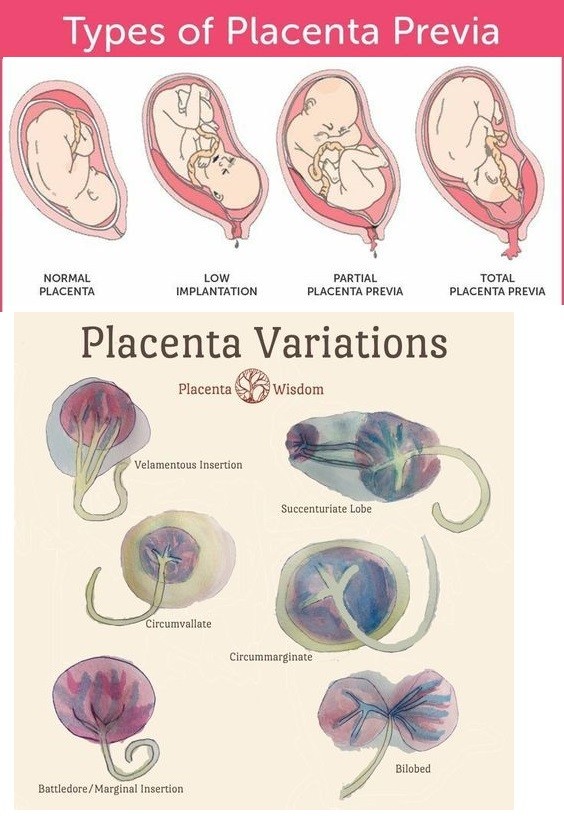
Contents
- 1 What Is a Placenta?
- 1.0.1 3 parts of the placenta
- 1.0.2 4 common types of placental placements
- 1.0.3 4 abnormal placental attachments
- 1.0.4 6 complications of the placenta
- 1.0.5 How does the placenta develop?
- 1.0.6 What factors influence the conditions of the placenta?
- 1.0.7 What are the signs of placental complications?
- 1.0.8 Subscribe to MedicineNet’s Pregnancy & Newborns Newsletter
What Is a Placenta?
During pregnancy, a special organ develops in the uterus to support the life of the fetus; this is known as the placenta. As the embryo implants in the uterus, some cells from the embryo transform into special structures, which eventually develop into the placenta.
One end of the placenta is attached directly to the uterus, and on the other end, it is attached to the fetus through the umbilical cord.
- The placenta provides the fetus with oxygen, nutrients, hormones, and other essential substances through the mother’s blood.
- It is vital for the survival of the fetus.
- The placenta removes metabolic waste products from the fetus.
After the baby is delivered, the placenta detaches from the uterus and is delivered. Delivery of the placenta is considered the third stage of labor.
The human placenta is discoid and hemochorial, which means it has a disc-shaped shape and the fetal part of the placenta (chorion) is in direct contact with the mother’s blood.
3 parts of the placenta
The placenta is divided into three layers:
- Amnion: The innermost layer that surrounds the fetus. The fetus is immersed in the amniotic fluid within the amniotic cavity. Amniotic fluid facilitates proper fetal development.
- Allantois: The middle layer of the placenta derived from the embryonic hindgut. It develops into the urachus, which drains fetal urine from the urinary bladder. The urachus passes through the umbilical cord.
- Chorion: The outermost layer of the placenta that contacts the endometrium (lining of the uterus). The chorion grows a dense network of blood vessels and forms a close relationship with the endometrium. The placenta, the embryo’s primary organ of respiration, feeding, and excretion, is formed by the chorion and endometrium. The chorion consists of two layers of cells: cytotrophoblast on the inner side and syncytiotrophoblast on the outer side.
4 common types of placental placements
The placenta can be placed in various locations, and here are a few of the most common ones:
- Posterior placenta: Develops in the back of the uterine wall, where the fertilized egg is attached.
- Anterior placenta: Adheres to the front wall of the uterus, with the fetus developing behind it.
- Fundal placenta: Attaches to the upper wall of the uterus.
- Left/right lateral placenta: Adheres to the left or right wall of the uterus.
QUESTION
4 abnormal placental attachments
Sometimes, the placenta attaches and grows in positions that cause complications during the development of the fetus or during vaginal delivery. These abnormal positions are detected during routine ultrasound scans.
- Placenta previa: Occurs when the placenta attaches low within the uterus, covering all or part of the cervix. There are three types of placenta previa based on how much the cervix is covered: complete previa, partial previa, and marginal previa.
- Placenta accreta: The placenta attaches too deeply to the uterine wall but does not penetrate the uterine muscle.
- Placenta increta: The placenta connects to the uterine wall even further and penetrates the uterine muscle.
- Placenta percreta: The placenta enters the uterine wall and joins another organ such as the bladder.
6 complications of the placenta
Complications related to the placenta are very rare, but when they occur, they can cause severe complications to the fetus and mother:
- Placenta previa: The placenta partially or completely covers the cervix, potentially requiring a cesarean delivery.
- Placenta accreta: The placenta develops too deeply into the uterine wall and can result in severe bleeding.
- Placental insufficiency: The placenta fails to provide enough nutrients to the fetus, leading to growth limitations and low birth weight.
- Infarcts in the placenta: Patches of dead tissue within the placenta caused by diminished blood flow. In severe cases, it can affect the unborn child.
- Placental abruption: The placenta separates from the uterus before delivery, leading to bleeding.
- Retained placenta: The placenta is not delivered within 30 minutes after the baby’s delivery, which can result in serious infection or blood loss.
How does the placenta develop?
The chorion develops about 10 days after conception when the fertilized egg implants in the uterus, forming the embryonic organ that precedes the placenta.
The placenta is fully developed by week 18 to 20 of pregnancy but continues to supply oxygen, nutrients, and immunity to the developing baby. By week 14 of pregnancy, the mother’s blood supply is attached to the developing placenta.
The placenta is composed of two components: the maternal placenta, which develops from the mother’s uterine tissue around 7 to 12 days after conception, and the fetal placenta, which forms when the blastocyst divides and attaches to the mother’s blood supply around 17 to 22 days after conception.
The umbilical cord connects the placenta to the baby’s abdomen, facilitating the exchange of pregnancy hormones and nutrients between the mother’s and baby’s blood supplies.
What factors influence the conditions of the placenta?
Factors that influence the health of the placenta include:
- Smoking history
- High blood pressure
- Multiple pregnancies
- Maternal blood-clotting disorders
- Uterine surgery, such as Cesarean delivery, in the past
- History of placental issues
- Cocaine usage by mothers (maternal substance misuse)
- Abdominal trauma, such as that caused by a fall or physical assault
- Maternal age (women older than 40 years are more likely to experience placental issues)
- Preterm membrane rupture and premature amniotic sac rupture increase the risk of placental complications
What are the signs of placental complications?
If a pregnant woman experiences symptoms such as vaginal bleeding, severe abdominal or back pain, or excessive uterine contractions, she must seek immediate medical attention. These symptoms can be caused by placental complications, which, if left untreated, can lead to serious complications and even fetal death.
In cases where vaginal delivery is not possible or poses serious complications due to specific placental complications, a doctor may perform a Cesarean delivery instead.
Subscribe to MedicineNet’s Pregnancy & Newborns Newsletter
By clicking "Submit," I agree to the MedicineNet Terms and Conditions and Privacy Policy. I also agree to receive emails from MedicineNet, and I understand that I may opt out of MedicineNet subscriptions at any time.


